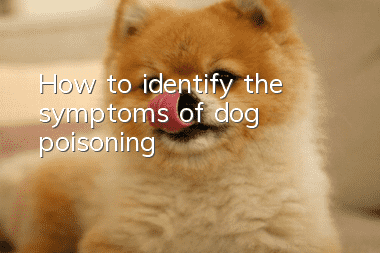How to identify the symptoms of dog poisoning

As the saying goes: "Diseases enter through the mouth." This sentence is not only a wise saying for humans, but also for animals.
I believe that many dog owners should have heard of news stories about dogs that were poisoned and died due to accidentally eating some food that they should not eat. Therefore, everyone needs to pay great attention to the diet of dogs, otherwise they will Your dog accidentally ran away from you.
Poisoning by endocrine rodenticides
This is a powerful rodenticide, a white, odorless crystalline powder that causes the permeability of pulmonary capillaries to increase and a large amount of plasma to enter the lung tissue, causing pulmonary edema. A few minutes to a few hours after the dog ingests it, he will vomit, foam at the mouth, then have diarrhea, cough, difficulty breathing, depression, visible mucosal cyanosis, and foamy bloody mucus flowing from the nostrils. Coma and drowsiness usually occur 10-12 hours after ingestion, and a few die within 2-4 hours after ingestion. There is no specific antidote for this poison. Methods of inducing vomiting, gastric lavage, catharsis and diuresis can be used.
Organofluoride rodenticide poisoning
This is a highly poisonous drug. 2-3 days after taking it, the sick dog will be restless, vomiting, gastrointestinal hyperfunction, running around, barking, and having paroxysmal spasms of the whole body, lasting about 1 minute, and finally death.
Zinc phosphide poisoning
This is a commonly used rodenticide in the form of gray powder. A few days after ingestion, it mixes with water and gastric acid in the stomach, releasing hydrogen phosphide gas and causing severe gastroenteritis. The sick dog suffered from abdominal pain, not eating, constant vomiting, coma and lethargy, and rapid and deep breathing. Suffocation, diarrhea, blood in stool.
Organophosphorus pesticide poisoning
Organophosphorus is widely used in agriculture as pesticides, such as trichlorfon, dimethoate, dichlorvos, etc. Accidental ingestion can cause excessive salivation, tearing, diarrhea, abdominal pain, urinary incontinence, difficulty breathing, coughing, conjunctival cyanosis, muscle twitching, and subsequent paralysis, miosis, and coma in dogs. Most deaths occur due to respiratory impairment.
Chlorinated hydrocarbon poisoning
Such pesticides include DDT, 666, etc. Causes the dog to be extremely excited, restless or highly depressed. The head and neck muscles will first tremble, and then spread to the whole body, with muscle spasm and contraction, and then depression; continuous bleeding, not eating or eating less, and diarrhea.
Phenol poisoning
Phenolic preparations are widely used in public health disinfection and veterinary clinical work. Preparations such as carbolic acid, lysolate, guaiacol, and xylene are common. As a corrosive and sterilizing agent, phenol can disinfect the ground, kennels, and large food utensils. If they are licked by dogs,At a certain amount, symptoms of poisoning will occur. Phenolic preparations can cause damage to the nervous system. The skin in contact with phenolic preparations becomes red and oozes. Sick dogs suffer from listlessness, vomiting, tonic spasms, and paralysis.
Chocolate (caffeine poisoning)
Poisoning symptoms:
Severe drooling, frequent urination, dilated pupils, rapid heartbeat, vomiting and diarrhea, high energy, muscle tremors, and finally coma.
Chocolate contains a large amount of theobromine, which can excite the central nervous system and increase heart rate.
It will reduce the blood flow to the dog's brain, which may cause heart disease and other potentially fatal problems.
Onions (disulfide poisoning)
Poisoning symptoms: weight loss, fatigue, laziness. Frequent wheezing, depression, rapid pulse, weakness, and film-like discharge from the gums and mouth.
Onions contain a special substance-n-propyl disulfide, which will destroy hemoglobin in dogs
After red blood cells are eroded by the reticuloendothelial system, anemia will occur and even damage the dog's bone marrow.
Liver (vitamin A poisoning)
Symptoms of poisoning: deformed bones, rapid bone development in elbows and spine, weight loss. Anorexia, loss of appetite.
Bones (not poisonous, but can scratch the esophagus and cause suffocation)
Suffocation reaction:
Pale and blue gums, panting, breathing through the mouth, scratching the face, shallow and slow breathing, unconsciousness, dilated pupils, and even shock.
Raw eggs (leading to lack of vitamin H)
Vitamin H deficiency: hair loss, weakness, growth retardation, skeletal deformities.
Grapes (causing kidney failure)
Symptoms of poisoning: vomiting, diarrhea, the dog will become depressed, loss of appetite, abdominal pain, and in severe cases, clinical oliguria, anuria, and finally renal failure.
Initial stage: Vomiting, loss of appetite, severe abdominal pain and diarrhea may occur 1-3 hours after eating grapes or raisins;
Mid-stage: weakness, tremors, thirst and dehydration;
- What to do if your dog is poisoned
- Ways to extend your dog’s lifespan
- Why doesn't Teddy dog eat?
- What fruits can dogs eat?
- Dog poop is white and lime-like
- What should you do if your dog is aggressive? What are the causes of aggressive dog behavior and how to correct it!
- What's going on when a puppy vomits?
- What should I do if my dog loses a lot of hair in summer?
- How should you feed your dog? Teach you how to feed your dog food correctly and scientifically
- Common dog allergy symptoms and allergens



